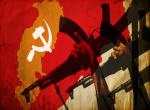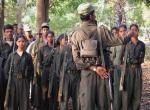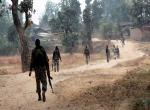In November 2004 when Prime Minister Manmohan Singh said that Left Wing extremism constituted “an even greater threat to India than militancy in Jammu & Kashmir and the North East”, the country took it seriously. They expected that the government would respond with appropriate urgency. Three years down the line, it is clear that that hasn’t happened and the situation has actually worsened. The spatial growth of the Maoist movement which has entrenched itself in new areas, increases in the incidents and intensity of extremist violence, the build-up of their material and manpower resources and their ability to run a parallel government in some areas proves that either response to the threat was not correctly assessed, or that it was flawed in terms of both policy formulation and its implementation.
Failure
The Prime Minister’s assertion last week that “we need to cripple the whole of Naxalite forces with all the means at our command”, is viewed with a pinch of salt. The skeptics doubt both the capability and intention of the powers that be to take the Naxal bull by the horns. When the government’s ability and sense of purpose to tackle serious problems gets eroded, then we have a situation more serious than the original problem. It saps the national will, the vital live force of a nation. Nothing more can enhance the trust and confidence between the rulers and the ruled than the former’s ability to keep their promises. That does not seem, not to be happening in our country. Failure is habit forming, and unless some innovative and bold initiatives are introduced, successive failures will visit us with greater frequency and virulence. Fortunately, the same is true for success. If we start succeeding, one success will follow the other in a cascading effect. At this point of time the most urgent requirement is for some quick tactical successes against the Left extremists that can put them on the defensive and push them to a strategic retreat. The intelligence agencies in coordination with the other central and state police forces are quite capable of achieving this. Success will come not through time-tested methods but innovative ideas, bold thinking and from a political leadership willing to bear the political costs without heeding their electoral compulsions. The political parties are aware that there over 60 parliamentary constituencies where Left extremists can influence the electoral process, both through coercion and persuasion. These are the areas where they are able to collect taxes, dispense justice through Jan Adalats and manipulate and coerce the inefficient, corrupt and demoralised government machinery into silence. The political system’s toleration if not patronage, of this governmental machinery is a two-edged sword. It prevents development reaching the deprived and alienated parts of the populace and also ensures that security agencies do not get adequate tactical support by the state governments. This nexus can only be broken if political parties, cutting across the party lines, can arrive at a political consensus to fight the menace. This also assumes importance as Left extremism has an ideological component for which only the political parties who owe allegiance stand for democracy and supremacy of the Constitution can provide an antidote. Very little has been done in the far flung affected tribal areas to politically educate and counter the pernicious ideology of Maoism. The masses have to be convinced that the political parties are both serious and capable of providing them social justice and equality, economic uplift, preservation of their life style and values through democratic means. Currently, there is a serious shortage of trust. The widening trust deficit between the political parties and people in the Maoist dominated areas is one of the factors responsible for extremists expanding their influence areas. Only mainstream political parties have an antidote to counter the poison of Left extremism by reaching to the people, providing them leadership in fighting injustice, real or imaginary, through democratically acceptable means. Unfortunately, the divisive politics of the country are more a cause than the cure of the problem. Further, quite often, political parties arrive at secret understandings with the extremists for electoral gains. Build-up
While strategic threats posed by the Left extremists to the Indian polity, and constitutional system are important, the concerns at security levels are immediate and pressing. In the last four years there has been an accretion of over 40 per cent in the cadre strength of Maoists from an estimated 5,000 in 2001 to over 7,500 in 2005. In the last year alone, over 1,000 new cadres joined the Maoist movement. While in 2001, 48 training camps were being run by them, the number increased to over 78 in 2005, depicting an increase of over 55 per cent. Similarly, improved communications across the country have worked as a major force multiplier: As part of their structural re-organisation, the earlier loosely constituted armed groups and dalams with a nebulous command and control system are being substituted by forming companies, platoons and sections in a military pattern. The People’s Liberation Guerrilla Army, the armed wing of the Communist Party of India (Maoist) is being structured on the model of People’s Guerrilla Army of the People’s War Group.The extremists are emphasising new and advanced skills to their cadres in terms of handling of weapons, fabrication of improvised explosive devices, field tactics, communications, collection of intelligence, etc. using the services of ex-servicemen and police personnel. There are unconfirmed reports of their having received training assistance from the Liberation Tigers of Tamil Eelam, particularly with regard to fabricating improvised explosive devices and mines. Their acquisition of new weapons with qualitative upgradation is also cause for concern. Till 2001, more than 60 per cent of their weapons were country-made guns which have now been substituted by AK series of assault rifles, grenade launchers, sten guns, and carbines. Their present weapon holding is estimated to be over 5,000. While earlier they were solely dependent on local suppliers of country-made weapons or weapons looted from security personnel, there are reports indicating their procurement chain through insurgent groups in the North-East, particularly the ULFA. Left extremists have also been using the United Liberation Front of Asom (ULFA) for channelling weapons through Bangladesh.
Strategy
One of the critical factors that has helped consolidation and expansion of Left extremism has been their sharply growing financial strength. They are able to raise huge funds by intimidating civil contractors, transporters, quarry and mill owners and by imposing levies on forest and coal produce. They also extort money from rich farmers and raise funds through imposition of fines, including on corrupt officials. Paradoxically, increased government outlays for development activities in affected areas often goes to strengthen them financially as the extremists, in collaboration with corrupt officials and local politicians, siphon off developmental funds with everybody finding it convenient to remain silent. The Prime Minister has spoken on the urgency of the Naxal problem. Clearly the time has now come for action. On that score, however, we can only wait and watch as to whether an effective strategy, which needs to be put in place immediately, is available to the governments at the Centre and the States. In the meantime, given the trends, the problem is likely to grow worse, before it becomes better.
The author is a former chief of the Intelligence Bureau
Published in Mailtoday on December 23, 2007









Post new comment